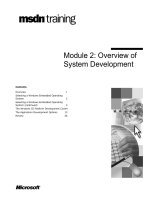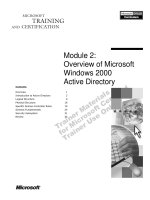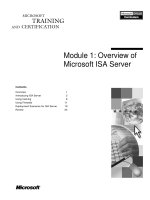Module 1: Overview of the Microsoft .NET Platform
Bạn đang xem bản rút gọn của tài liệu. Xem và tải ngay bản đầy đủ của tài liệu tại đây (800.03 KB, 22 trang )
Contents
Overview 1
Introduction to the .NET Platform 2
Overview of the .NET Framework 5
Benefits of the .NET Framework 7
The .NET Framework Components 8
Languages in the .NET Framework 14
Review 16
Module 1: Overview of
the Microsoft .NET
Platform
Information in this document, including URL and other Internet Web site references, is subject to
change without notice. Unless otherwise noted, the example companies, organizations, products,
domain names, e-mail addresses, logos, people, places, and events depicted herein are fictitious,
and no association with any real company, organization, product, domain name, e-mail address,
logo, person, places or events is intended or should be inferred. Complying with all applicable
copyright laws is the responsibility of the user. Without limiting the rights under copyright, no
part of this document may be reproduced, stored in or introduced into a retrieval system, or
transmitted in any form or by any means (electronic, mechanical, photocopying, recording, or
otherwise), or for any purpose, without the express written permission of Microsoft Corporation.
Microsoft may have patents, patent applications, trademarks, copyrights, or other intellectual
property rights covering subject matter in this document. Except as expressly provided in any
written license agreement from Microsoft, the furnishing of this document does not give you any
license to these patents, trademarks, copyrights, or other intellectual property.
2001−2002 Microsoft Corporation. All rights reserved.
Microsoft, MS-DOS, Windows, Windows NT, ActiveX, BizTalk, IntelliSense, JScript, MSDN,
PowerPoint, SQL Server, Visual Basic, Visual C++, Visual C#, Visual J#, Visual Studio, and
Win32 are either registered trademarks or trademarks of Microsoft Corporation in the U.S.A.
and/or other countries.
The names of actual companies and products mentioned herein may be the trademarks of their
respective owners.
Module 1: Overview of the Microsoft .NET Platform iii
Instructor Notes
The module starts with an overview of the Microsoft
®
.NET Platform, and then
introduces the .NET Framework and services. It describes the design goals and
language support of the .NET Framework. The module concludes by providing
more information about the major components of the .NET Framework.
This module provides students with an overview of the Microsoft .NET
Platform. It defines some of the terminology specific to the .NET Platform and
describes its key features and benefits.
Do not spend too much time on this module. This module is only meant to
provide an overview, so do not go into too much detail. While teaching the
module, focus mainly on the .NET Framework Components section.
This module contains no labs.
After completing this module, students will be able to:
Describe the .NET Platform.
List the main elements of the .NET Platform.
Describe the .NET Framework and its components.
Explain the language support in the .NET Framework.
Materials and Preparation
This section provides the materials and preparation tasks that you need to teach
this module.
Required Materials
To teach this module, you need the following materials:
Microsoft PowerPoint
®
file 2124C_01.ppt
Module 1, “Overview of the Microsoft .NET Platform”
Preparation Tasks
To prepare for this module, you should:
Read all of the materials for this module.
Read the instructor notes and the margin notes for the module.
Presentation:
30 Minutes
Lab:
00 Minutes
iv Module 1: Overview of the Microsoft .NET Platform
Module Strategy
Use the following strategy to present this module:
Introduction to the .NET Platform
Discuss the core services and technologies provided by the .NET Platform.
Briefly talk about the .NET Framework. It is covered later in more detail.
Overview of the .NET Framework
Ensure that students understand the role that the common language
specification plays in language development for the .NET Platform. Stress
the fact that the existing model provides no consistency in the availability of
application programming interfaces (APIs). The choice of programming
model also becomes the choice of language. For example, if you are a
Microsoft Visual Basic
®
developer, you are limited by the functionality that
Visual Basic provides for the platform, or if you are a C++ programmer,
your existing skills do not transfer to Active Server Pages (ASP)
development.
Benefits of the .NET Framework
Review the important design goals of the .NET Platform and how each of
these goals helps developers create Web-based distributed applications.
The .NET Framework Components
Briefly describe each of the .NET Framework components. The ADO.NET:
Data and XML topic does not provide a lot of detail because these topics are
not the focus of the course.
Languages in the .NET Framework
Mention that C# is the premier language of the .NET Platform, and that it is
best suited to take advantage of the .NET Framework. Explain that both
Visual Basic and Microsoft Visual C++
®
have been upgraded to support the
.NET Platform. Explain that Microsoft Visual J#™ .NET has been
developed for Java-language developers who want to build applications and
services on the .NET Framework. Third parties are also developing
languages to support .NET.
Module 1: Overview of the Microsoft .NET Platform 1
Overview
Introduction to the .NET Platform
Overview of the .NET Framework
Benefits of the .NET Framework
The .NET Framework Components
Languages in the .NET Framework
*****************************
ILLEGAL FOR NON
-
TRAINER USE
******************************
The Microsoft
®
.NET Platform provides all of the tools and technologies that
you need to build distributed Web applications. It exposes a language-
independent, consistent programming model across all tiers of an application
while providing seamless interoperability with, and easy migration from,
existing technologies. The .NET Platform fully supports the Internet’s platform-
neutral, standards-based technologies, including Hypertext Transfer Protocol
(HTTP), Extensible Markup Language (XML), and SOAP.
C# is a new language specifically designed for building .NET applications. As a
developer, you will find it useful to understand the rationale and features that
provide the foundation for the .NET Platform before you start writing C# code.
After completing this module, you will be able to:
Describe the .NET Platform.
List the main elements of the .NET Platform.
Describe the .NET Framework and its components.
Explain the language support in the .NET Framework.
Topic Objective
To provide an overview of
the module topics and
objectives.
Lead-in
In this module, you will be
introduced to the .NET
Platform. You will then learn
about the .NET Framework
and the language support
that the .NET Framework
provides for the platform.
2 Module 1: Overview of the Microsoft .NET Platform
Introduction to the .NET Platform
The .NET Framework
.NET My Services
The .NET Enterprise Servers
Visual Studio .NET
*****************************
ILLEGAL FOR NON
-
TRAINER USE
******************************
The .NET Platform provides several core technologies, as shown on the slide.
These technologies are described in the following topics.
The .NET Framework
The .NET Framework is based on a new common language runtime. The
common language runtime provides a common set of services for projects built
in Microsoft Visual Studio
®
.NET, regardless of the language. These services
provide key building blocks for applications of any type, across all application
tiers.
Microsoft Visual Basic
®
, Microsoft Visual C++
®
, and other Microsoft
programming languages have been enhanced to take advantage of these
services. Microsoft Visual J#™ .NET has been developed for Java-language
developers who want to build applications and services using the .NET
Framework. Third-party languages that are written for the .NET Platform also
have access to the same services. The .NET Framework is explained in greater
detail later in this module.
.NET My Services
.NET My Services is a set of user-centric XML Web services. With .NET My
Services, users receive relevant information as they need it, delivered to the
devices they are using, and based on preferences they have established. Using
.NET My Services, applications can communicate directly by using SOAP and
XML from any platform that supports SOAP.
Topic Objective
To discuss the core services
and features in the .NET
Platform.
Lead-in
The .NET Platform consists
of several core services and
features, as is shown on the
slide. The goal of this new
platform is to simplify Web
development. This section
will provide a brief look at
the major areas of the .NET
Platform.
Module 1: Overview of the Microsoft .NET Platform 3
Core .NET My Services include:
.NET Passport authentication
The ability to send alerts and manage preferences for receiving alerts
The storage of personal information (including contacts, e-mail, calendar,
profile, lists, electronic wallet, and physical location)
The ability to maintain document stores, save application settings, record
favorite Web sites, and note devices owned.
The .NET Enterprise Servers
The .NET Enterprise Servers provide scalability, reliability, management,
integration within and across organizations, and many other features, as
described in the following table.
Server Description
Microsoft SQL Server
™
Includes rich XML functionality, support for Worldwide Web Consortium (W3C)
standards, the ability to manipulate XML data by using Transact SQL (T-SQL),
flexible and powerful Web-based analysis, and secure access to your data over the
Web by using HTTP.
Microsoft BizTalk
™
Server Provides enterprise application integration (EAI), business-to-business integration,
and the advanced BizTalk Orchestration technology to build dynamic business
processes that span applications, platforms, and organizations over the Internet.
Microsoft Host Integration
Server
Provides the best way to embrace Internet, intranet, and client/server technologies
while preserving investments in existing earlier systems.
Microsoft Exchange Enterprise
Server
Builds on the powerful Exchange messaging and collaboration technology by
introducing several important new features and further increasing the reliability,
scalability, and performance of its core architecture. Other features enhance the
integration of Exchange with Microsoft Windows
®
, Microsoft Office, and the
Internet.
Microsoft Application Center Provides a deployment and management tool for high-availability Web
applications.
Microsoft Internet Security and
Acceleration Server
Provides secure, fast, and manageable Internet connectivity. Internet Security and
Acceleration Server integrates an extensible, multilayer enterprise firewall and a
scalable high-
performance Web cache. It builds on Windows security and directory
for policy-based security, acceleration, and management of internetworking.
Microsoft Commerce Server Provides an application framework, sophisticated feedback mechanisms, and
analytical capabilities.
Microsoft SharePoint
™
Portal
Server
Provides the ability to create corporate Web portals with document management,
content searching, and team collaboration features.
Microsoft Mobile Information
Server
Integrates with the Microsoft .NET Enterprise Servers and Microsoft Windows
®
to
provide secure communications and data exchange with mobile devices. High
reliability, scalability, and performance are achieved by using clustering,
replication, load balancing, and content delivery.
Microsoft Content Management
Server
Offers complete feature sets for content contribution and delivery, site
development, and enterprise site management to enable businesses to effectively
create, deploy, and manage Internet, intranet, and extranet Web sites.
4 Module 1: Overview of the Microsoft .NET Platform
Visual Studio .NET
Visual Studio .NET provides a development environment for building
applications on the .NET Framework. It provides important enabling
technologies to simplify the creation, deployment, and ongoing evolution of
secure, scalable, highly available Web applications and XML Web services.









